![]()
![]()
![]()
Use LEFT and RIGHT arrow keys to navigate between flashcards;
Use UP and DOWN arrow keys to flip the card;
H to show hint;
A reads text to speech;
212 Cards in this Set
- Front
- Back
|
mixing movement of intestine, frequency
|
2-3/min
|
|
|
propulsive waves - speed, fades after how long
|
0-5-2cm/s (decrease in anal direction), u 3-5 cm (can be up to 10cm)
|
|
|
gastrin, from where, which effect
|
1 antrum, duodenum 2 HCl stomach motility
|
|
|
intestinal bacteria, function
|
1 digest fiber 2 produce vit K 3 acidify 4 produce gases (CO2, methane, H2)
|
|
|
gastrin - 1 from 2 stimuli for secretion 3 effect
|
1 distension, small peptides+AAs, vagus 2 g cells of antrum 3 ↑HCl
|
|
|
secretin, 1 from 2 stimuli 3 action
|
1 S cells of duodenum 2 acids, FAs 3 ↑pepsin, ↑HCO3 (pancreatic, biliary), ↓HCl
|
|
|
CCK, 1 from 2 stimuli 3 action
|
1 cells (I cells) of duodenum and jejunum 2 small peptides+AAs, FAs 3 ↑pancreatic enzymes and bicarbonate, gallbladder contraction, ↓gastric emptying
|
|
|
gastric inhibitory peptide (GIP), 1 from 2 stimuli 3 action
|
1 cells (K cells) of duodenum and jejunum) 2 FAs, AAs, oral glucose 3 ↑insulin, ↓HCl
|
|
|
somatostatin/GHIH, 1 from 2 action
|
1 whole GIT 2 inhibit secretion of all hormones (gastrin, VIp, GIP, secretin, motilin)
|
|
|
VIP (vasoactive intestinal peptide), 1 from 2 action
|
1 whole GIT 2 ↓HCl, ↑intestinal secretion
|
|
|
CGRP/calctinon gene-related peptide, from, action
|
1 neurons of GIT 2 ↓HCl, ↑somatostatin+Ach (GI activation), ↑vasodilation
|
|
|
pancreatic polypeptide (PP), 1 from 2 action
|
1 endocrine cells of pancreas 2 ↑esophageal tonus, ↓exocrine pancreas
|
|
|
motilin, 1 from 2 effect
|
1 jejunum 2 ↑stomach motility
|
|
|
Brunner glands, stimuli for release
|
1 chyme (mechanically and chemically) 2 vagus 3 humoral - secretin
|
|
|
Brunner/Duodenal glands, where, secrete what, how much water
|
first part of duodenum, alkaline mucous and bicarbonate, 200mL/day
|
|
|
control of peristalsis
|
neural (reflex - chyme into duodenum), humoral (+ gastrin, CCK, insulin, serotonin, - secretin, glucagon)
|
|
|
crypts of Lieberkuhn/intestinal glands, where, secrete what, how much fluid
|
entire small intestine, mucus+water+electrolytes, 1800 mL/day
|
|
|
gastrin-releasing peptide (GRP),1 from 2 action
|
1 neurons of vagus innervating G cells 2 ↑gastrin+CCK+PP+somatostatin
|
|
|
gastrocolic reflex
|
increase in motility of colon in response to gastric distension and byproducts of digestion in the small intestine (responsible for defecation urge after meal)
|
|
|
gastroenteric reflex
|
increase rate of peristalsis and secretion along the small intestine (by distension of stomach)
|
|
|
gastroileal reflex
|
empties terminal portion of ileum (by distension of stomach)
|
|
|
iliocecal valve, what can cause the sphincter to contract and inhibit peristalsis
|
irritation/distension of cecum (ie appendicitis)
|
|
|
Mass movements of Holzknecht, caused by, what, when
|
1 gastrocolic or duodenocolic reflex 2 forced circular contraction in colon transversum - distal part lose its haustrations and contract for 2-3 min (repeated for 30min), after breakfast (repeated after 12-24h)
|
|
|
propulsive movements of colon
|
1 haustrations (slow, persisting) 2 mass movements of Holzkecht (1-3/day)
|
|
|
why is rectum empty of feces
|
due to rectosigmoideal sphincter, which is located 20cm from anus
|
|
|
Gut intrinsic innervation: myenteric plexus vs submucosal plexus function
|
Myenteric: motility. Submucosal: secretion and blood flow
|
|
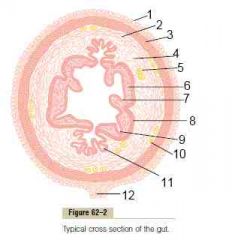
|

(Guyton)
|
|
|
Slow waves of gastrointestinal smooth muscle
a. Mechanism b. Rate c. Cause contraction? |
a. Complex interactions between smooth muscle cells and Interstitial cells of Cajal, the latter are believed to act as electrical pacemakers
(Interposed between the smooth muscle layers with synaptic-like connections) b. 3-12. 3 in stomach, 12 in duodenum (9 in terminal ileum) c. Cause contraction secondarily by initiating spike potentials (real action potentials)). The reason for this is because they only cause sodium ions to enter. (Resting membrane potential is -50 to -60 mV (-56 mV average), slow wave potential is 5-15 mV and threshold for spike potential is -40 mV) (Guyton) |
|
|
Spike potentials of gastrointestinal smooth muscle
a. Caused by b. Relative duration compared to action potential of large nerve fibers, why? |
a. Higher slow wave potential -> greater frequency of spike potentials generated
b. Much longer (10-40 times as long), due to slowness of opening and closing of the calcium-sodium (Resting membrane potential is -50 to -60 mV (-56 mV average), slow wave potential is 5-15 mV and threshold for spike potential is -40 mV) (Guyton) |
|
|
Resting membrane potential of smooth muscle of the gastrointestinal tract
a. Factors causing depolarization (3) b. Factors causing hyperpolarization (2) |
a.
1. Stimulation of acetylcholine receptors 2. Stretch 3. Several gastrointestinal hormones b. 1. Stimulation of adrenergic receptors 2. Several gastrointestinal hormones (Guyton) |
|
|
Enteric nervous system
a. From, to b. Components & functions c. Number of neurons |
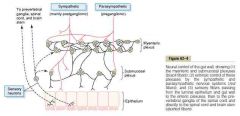
a. Esophagus to anus
b. 1. Myenteric\Auerbach plexus - motility (Stimulatory stimuli cause increased tonic contraction\tone of the gut wall, increased intensity of the slow waves, slightly increased rate of slow wavs, increased velocity of conduction of excitatory waves along the gut wall, causing more rapid movement of the gut peristaltic waves.) (Also inhibitory signals, perhaps by VIP, especially useful for sphincters) 2. Submucosal\Meissner plexus -> secretions, local absporption, blood flow, contraction of the submucosal muscle (various degrees of infolding of the GI mucosa) c. 100 million neurons (Almost equal to the number in the spinal cord) (Guyton) |
|
|
Neurotransmitters secreted by enteric neurons (11)
|
1. Acetylcholine
2. Norepinephrine & epinephrine 3. ADP 4. Serotonin 5. Dopamine 6. CCK 7. Substance P 8. Vasoactive intestinal polypeptide (VIP) 9. Somatostati 10. Met-enkephalin, leu-enkephalin 11. Bombesin (Guyton) |
|
|
Effect of sympathetic innervation on GI tract (2)
|
1. Direct effect of secreted NE to inhibit intestinal tract smooth muscle and excite submucosal muscle
2. Inhibitory effect on the neurons of the enteric nervous system (Strong stimulation can inhibit motor movement of the gut enough to block movement of food) (Guyton) |
|
|
Sensory neurons of the GIT
a. Location (2) b. Destination (4) c. Eliciting stimuli (3) |
a. In enteric nervous system itself or in the dorsal root ganglia of the spinal cord
b. 1. Both enteric plexuses 2. To the prevertebral ganglia of the sympathetic nervous system 3. To the spinal cord 4. To the brain stem via the vagus nerve (80% of fibers in vagus nerve is afferent) c. 1. Irritation of the gut mucosa 2. Excessive distention of the gut 3. Specific chemical substances in the gut (Guyton) |
|
|
Gastrointestinal reflexes - types (3)
|
1. Reflexes that are integrated entirely within the gut wall
(GI secretions, peristalsis, mixing contractions..) 2. Reflexes from the gut to the prevertebral sympathetic ganglia and then back to the GI tract 3. Reflexes from the gut to the spinal cord or brain stem and then back to the GI tract (Guyton) |
|
|
Reflexes from the gut to the prevertebral sympathetic ganglia and then back to the gastrointestinal tract
a. General description of reflexes b. Examples (3) |
a. Long-distance reflexes
b. 1. Gastrocolic reflex (Signals from the stomach to cause evacuation of the colon) 2. Enterogastric reflexes (Signals from the colon and small intestine to inhibit stomach motility and secretion) 3. Colonoileal reflex (Reflexes from the colon to inhibit emptying of ileal contents into the colon) (Guyton) |
|
|
Motilin
a. Secreted by b. Stimuli for release c. Effect |
a. Upper duodenum
b. Fasting c. Increase gastrointestinal motility - stimulate waves of GI motility called interdigestive myoelectric complexes (Released cyclically and stimulates waves of gastrointestinal motility called interdigestive myoelectric complexes that move through the stomach and small intestine every 90 minutes in a fasted person.) (Guyton) |
|
|
Functional types of movements in the gastrointestinal tract
|
1. Peristalsis
(Inherent property of many syncytial smooth muscle - glandular ducts, ureters, bile ducts... The usual stimulus is distention, also chemical or physical irritation of the epithelia and parasympathetic nervous signals) (Absent in persons with congeital absence of myenteric plexus - Hirschprung disease or when given atropine) 2. Mixing movements |
|
|
The law of the gut
|
The peristaltic\myenteric reflex (contraction above and relaxation below (receptive relaxation) a stimulated point in the intestine) plus the anal direction of movement of the peristalsis.
(Guyton) |
|
|
The splanchnic circulation
a. What b. Function |
a. All drained by the hepatic portal vein - GIT, spleen, plancreas, and liver.
b. 1. The reticuloendothelial cells that line the liver sinusoids have a chance to remove pathogens before it reach the rest of the circulation 2. Nonfat, water-soluble nutrients are absorbed in the liver sinusoids by reticuloendothelial cells and parenchymal hepatocytes (Absorb and store temporarily 50-75% of the nutrients) (Guyton) |
|
|
Organization of blood flow and lymphatic drainage through an intestinal villus
|
Small arteriole and venule that interconnect with a system of multiple looping capillaries.
Central lacteal lymphatic capillary. (The blindly ending lymphatic capillary in the center of an intestinal villus) (Guyton) |
|
|
Organization of blood flow and lymphatic drainage through an intestinal villus
|
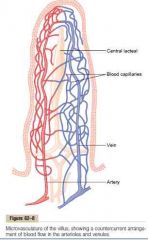
Central lacteal lymphatic capillary.
(The blindly ending lymphatic capillary in the center of an intestinal villus) Small arteriole and venule that interconnect with a system of multiple looping capillaries, and form a countercurrent mechanism (flow in opposite direction and lie next to each other). (Cause shunting of oxygen directly from arteriole to venule. In disease conditions in which blood flow to the gut becomes greatly curtailed (ie shock), the oxygen deficit in the tips of the villi can become so great that the villus tip or even the whole villus suffers ischemic death and can disintegrate. For this reason (and others), in many GI diseases the villi become seriously blunted, leading to greatly diminished intestinal absorptive capacity) (Guyton) |
|
|
During active absorption of nutrients blood flow in the villi and adjacent regions of the submucosa is increased as much as eightfold. What are the possible reasons for this (3)?
|
1. Several vasodilator substances are released from the mucosa of the intestinal tract during the digestive process - CCK, VIP, gastrin, secretin
2. Some of the GI glands also release into the gut wall two kinins - kallidin and bradykinin at the same time that they secrete their exocrine secretions to the lumen 3. Normal metabolic control (Guyton) |
|
|
Maximum amount of force produced by masticatory muscles?
|
90kg
(On the molars - the grinders, and 25kg on the incisors - the cutters) (Guyton) |
|
|
Chewing reflex
|
1. Presence of bolus in mouth initiates a reflex inhibition of masticatory muscles -> jaw drop
2. Jaw drop -> stretch reflex -> rebound contraction 3. Compress the bolus against the linings of the mouth -> inhibits the masticatory muscles again... (Chewing is especially important for fruits and raw vegetables because these have indigestible cellulose membranes around their nutrient portions that must be broken before the food can be digested) (Also increase surface area of food, decrease risk of excoriation (abrasion) and ease defecation) (Guyton) |
|
|
Swallowing
a. Synonym b. Stages |
a. Deglutition
b. 1. Voluntary stage (Food is squeezed posteriorly into the pharynx by the tongue, only voluntary stage) 2. Pharyngeal stage 3. Esophageal stage (Primary peristalsis is continuation of peristalsis from the pharynx - 8-10 seconds, secondary peristaltic waves are initiated by intrinsic neural circuits in the myenteric plexus and partly by reflexes that begin in the pharynx -> vagal afferent -> medulla -> vagal and glossopharyngeal efferents) (Cause receptive relaxation of the stomach transmitted through myenteric inhibitory neurons) (Guyton) |
|
|
Pharyngeal stage of swallowing
a. Initiated by, afferents b. Control center c. Efferent part of reflex |
a. Epithelial swallowing receptor areas - round opening of the pharynx (especially tonsillar pilars) -> CN V, CN X
b. Deglutition center in lower pons and medulla (tractus solitarius is part of its sensory part) -> CN V, IX, X, XII, superior cervical nerves c. 1. Levator veli palatini (CN IX) pulls the soft palate up -> close nasopharynx 2. Palatopharyngeal muscles (CN IX) contract -> thin slit which food must go through to pass into esophagus - size filter 3. Larynx close (CN X): moved anteriorly and superiorly -> close epiglottis, vocal cords close 4. Anterosuperior movement of larynx and relaxation of upper esophageal sphincter \pahryngoesophageal sphincter relax -> ease food movement 5. The whole muscular wall of pharynx contract in a peristaltic manner (Simultaneously inhibit respiratory center) (Guyton) |
|
|
Gastroesophageal reflux
a. Which two mechanisms helps prevent gastroesophageal reflux? b. Importance c. Name for condition where the gastroesophageal sphincter fails to relax properly |
a.
1. Gastroesophageal\lower esophageal sphincter (maintain tonic contraction, 30 mmHg intraluminal pressure) 2. Valve function of "flaps" of lower portion of esophagus into stomach b. The stomach secretions are highly acidic and contain many proteolytic enzymes. Only the distal 1\8 of the esophageal mucosa is capable of reesisting for long the digestive action of gastric secretions. c. Achalasia (chalasis: slackening) (Guyton) |
|
|
Physiological division of the stomach
|
1. Orad part - proximal 2\3 of the body
2. Caudad part - distal 1\3 of the body and antrum (Guyton) |
|
|
Storage function of the stomach
a. Reflex that relaxes the stomach as it gets progressively more filled b. Maximum storage capacity |
a. Vagovagal reflex - reduce muscular tone
b. 0.8-1.5L (Guyton) |
|
|
Chyme - what
|
The mixture resulting from food boluses being mixed with stomach secretions
(Guyton) |
|
|
Mixing mechanism of stomach
|
Distally moving constrictor waves (3-4\min, slow-wave initiated) combined with upstream squeezing action (retropulsion) of pyloric sphincter.
(Guyton) |
|
|
Hunger contractions
a. What b. Hunger pangs |
a. Intense contractions that occur a. when the stomach has been empty for several hours or more.
(Can superimpose and cause continuous tetanic contraction for 2-3 minutes) (Strongest in young healthy people and in hypoglycemic states) b. Mild pain in stomach region caused by excessive hunger contractions. (Usually don't appear until at least 12 hours of starvation, peak at 3-4 days of starvation) (Guyton) |
|
|
Stomach emptying
a. Mechanism b. Regulation |
a. 20% of the constrictor waves is about 6 times as powerful and cause emptying - therefore the peristaltic waves are called pyloric pump
(Only several mL each time) (The pyloric sphincter only allow passage of particles when they have become mixed in the chyme to almost fluid consistency) b. Gastric factors that promote emptying 1. Increased gastric food volume -> local myenteric reflexes -> accentuate pyloric pump & inhibit pyloric sphincter 2. Gastrin -> increased motility -> increased pyloric pump activity (<- stretch, protein. secreted from antral mucosa. Also cause secretion of acidic gastric juice) Duodenal factors that inhibit stomach emptying - most important 1. Enterogastric inhibitory nervous feedback reflexes 2. Hormonal feedback from CCK (fats), Secretin (acidity), and GIP (fats) (Mostly to fats since these take longest to digest. (Guyton) |
|
|
Enterogastric inhibitory nervous reflexes
a. Stimuli (5) b. Pathways c. Effect |
a.
1. Degree of duodenal distention 2. Irritation in the duodenal mucosa 3. Acidity of the duodenal chyme (below 3.5-4) 4. Hypo-\Hyperosmolality of chyme (-> prevent electrolyte disturbances) 5. Presence of certain breakdown products of proteins and perhaps fats b. 1. Directly from duodenum to stomach via enteric nervous system 2. Through extrinsic nerves that go to the prevertebral sympathetic ganglia and then back through inhibitory sympathetic fibers 3. Vagus -> brain stem -> inhibition of excitatory signals c. Inhibit pyloric pump and stimulate pyloric sphincter |
|
|
Propulsive movements in the small intestine
a. Speed b. Length of travel c. Net movement d. Time for passage of chyme through small intestine |
a. 0.5-2 cm\s
b. 3-5 cm c. 1 cm\min d. 3-5 hours (Also facilitated by the mixing segmentation contractions, although they only travel about 1 cm each time) (Guyton) |
|
|
Control of peristalsis
a. Hormonal - stimulated by (5) b. Hormonal - inhibited by (2) b. Nervous |
a.
1. Gastrin 2. CCK 3. Insulin 4. Motilin 5. Serotonin b. 1. Glucagon 2. Secretin c. 1. Gastroenteric reflex (distention of stomach -> myenteric plexus -> increase motility in small intestine) 2. Gastroileal reflex (distention of stomach -> increase motility in ileum) |
|
|
Muscularis mucosae
a. Contraction elicited by b. Effect |
a. Local nervous reflexes in resposne to chyme in the small intestine
b. 1. Cause folding of mucosa -> increase surface area for absorption 2. Muscle fibers extending into villi cause pumping movement of villi which facilitate lymph flow through central lacteals. (Guyton) |
|
|
Control of the ileocecal sphincter
a. Factors inhibiting emptying (3) b. Factors promoting emptying (3) |
a.
1. Pressure in cecum 2. Irritant in cecum (ie inflamed appendix) (Can completely block emptying) b. 1. Fluidity of ileum 2. Pressure in ileum 3. Irritants in ileum (Reflexes are intrinsic or mostly go via prevertebral sympathetic ganglia) (Guyton) |
|
|
Colon - function
|
1. Absorption of water and electrolyte from the chyme
(Form solid feces) 2. Storage of fecal matter until it can be expelled (80-200 mL of feces are expelled each day) (Guyton) |
|
|
Movements of colon - types
|
1. Mixing movements are called haustrations
(Combined contraction of 2.5 cm of circular muscle and longitudinal teniae coli muscles produce outward bulging sacs called haustrations)(Last about 60 seconds)(Move the chyme through the colon in 8-15 hours) 2. Propulsive movements are called mass movements of Holzknecht (1-3 times daily, contract for 2-3 minutes, especially after breakfast and meals (<- gastrocolic, duodenocolic reflexes via autonomic nervous system), a series last for 15-30 minutes) (Constrictive ring occurs (<- distention, irritation) -> receptive relaxation up to 20 cm distally (lose their haustrations) -> contract as unit) (Irritation such as from ulcerative colitis can increase frequency dramatically) (Guyton) |
|
|
The rectum is empty of feces most of the time - which three factors contribute to this?
|
1. Weak functional sphincter exists 20 cm from the anus at the junction between the Sigmoid colon and rectum
2. Sharp angulation here -> cause additional resistance 3. Rapid emptying when it is filled (Guyton) |
|
|
Defecation reflexes
a. Intrinsic defecation reflex b. Parasympathetic defecation reflex |
a. Feces enter the rectum -> distention -> myenteric plexus -> peristaltic waves in descending colon, sigmoid and rectum. Inhibition of internal sphincter
(Relatively weak and usually not adequate on its own) b. Nerve endings in rectum -> conus medullaris -> pelvic nerves (parasympathetic) -> increase peristalsis in descending colon, sigmoid colon, rectum and anus, and inhibit internal sphincter (Also initiate other effects: taking a deep breath, closure of the glottis, contraction of abdominal muscles, relaxation of pelvic floor) (In newborn babies and in some people with transected spinal cords above the conus medullaris, the defecation reflexes cause automatic emptying because of lack of conscious control of external anal sphincter) (Guyton) |
|
|
Peritoneointestinal, renointestinal, and vesicointestinal reflexes
|
Irritation (peritoneum, spleen, kidney) -> strongly inhibit excitatory enteric nerves -> intestinal paralysis
(Especially in patients with peritonitis) (Guyton) |
|
|
Secretory glands
a. The two functions b. Location |
a.
1. Secrete digestive enzymes 2. Secrete mucus b. 1. Mouth -> distal ileum 2. Mouth -> anus (Guyton) |
|
|
Secretory glands of GIT - types (5)
|
a.
1. Goblet\Mucous cells - single-cell mucous glands (most part of the GIT, stimuli is local irritation) 2. Crypts of Lieberkuhn in submucosa of small intestine (Have specialized secretory cells) 3. Deep tubular glands in stomach (oxyntic and pyloric) and upper duodenum 4. Complex glands - salivary glands, pancreas, liver 5. Componund mucous glands - Brunner glands in duodenum, in esophagus (Guyton) |
|
|
Secretory glands - stimuli (5)
|
1. Local direct effect - especially on Goblet cells
2. Local effect that activate the enteric nervous system (Tactile, chemical, distention) 3. Parasympathetic stimulation (Large effect on salivary glands, esophageal glands, gastric glands, pancreas, Brunner's glands and glands in distal third of colon) (Less effect from distal duodenum to first two thirds of large intestine) 4. Sympathetic stimuli (Can have mild stimulatory effect on glands, but this is opposed by their vasoconstrictive effects) 5. Hormonal regulation (Especially useful to increase the output of gastric juice and pancreatic juice when food enters the stomach or duodenum) (Guyton) (Guyton) |
|
|
How are nervous and hormonal stimulation believed to control amount of water and electrolyte secretions of glands?
|
1. Stimuli cause active transport of chloride into the basal portion of the cell
2. The increased electronegativity cause positive ions to follow 3. Osmotic gradients cause water to follow 4. The cell swell and the intracellular hydrostatic pressure increase -> the increased pressure initiates minute openings on the apical portions -> outflow of water, electrolytes and organic materials (Parasympatethic stimulation cause increased intracellular polarization and act mainly on the basal part) (Guyton) |
|
|
Mucus
a. Components (3) b. Important characteristics (6) |
a.
1. Water 2. Electrolytes, thereunder bicarbonate 3. Mixture of large glycoproteins b. 1. Its chemical properties make it adhere tightly to food and other particles and spread as a surface film over them 2. Coat mucosa and prevent direct contact to the epithelium of the gut 3. Low resistance for slippage -> increased sliding -> decreased excoriation 4. Cause fecal particles to adhere to one another 5. Strongly resistant to digestion of GI enzymes 6. The glycoproteins have amphoteric properties (can buffer small amounts of acid or base) |
|
|
Salivary glands
a. Daily secretion b. Types and composition of secretions c. Which glands secrete what |
a. 1000 mL
b. 1. Serous - have ptyalin (an alpha-amylase) 2. Mucous - have mucin (The electrolytes in both contain much bicarbonate and potassium. K is secreted in glandular ducts while Na is reabsorbed, HCO3 is high because they are passively exchanged by Cl) c. 1. Serous: parotid glands (almost completely), 2. Mucous: buccal glands 3. Mixed: submandibular glands, sublingual glands (Have pH of 6-7, facilitate ptyalin) (K: 30 mM, Na: 14 mM, HCO3: 50-70 mM) (Guyton) |
|
|
Saliva - antibiotic mechanisms (4)
|
1. Flow of saliva wash away pathogens and their food substrates
2. Contain bactericidal substances: thiocyanate, proteolytic enzymes (lysozyme is the most important) 3. Digest food substrates for the bacteria 4. Secretory antibodies (In the absence of saliva, oral tissues often become ulcerated and otherwise infected) (Guyton) |
|
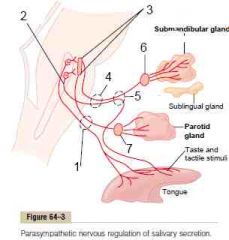
|

(Especially the sour taste (caused by acids) elicits copious salivary secretions)
(Smooth objects cause more salivation than rough objects) (Salivation can also be stimulated or inhibited by higher cortical centers acting on the salivatory nuclei. Cortical areas\amygdala -> appeptite area (anterior hypothalamus) -> salivatory nuclei) (Sympathetic stimulation from superior cervical ganglia -> increase salivation slightly) (Salivatory glands have autacoid mechanisms for vasodilation. After stimulation they secrete kallikrein which splits a alpha-2-globulin to form bradykinin, a strong vasodilator) (Guyton) |
|
|
Esophageal secretion
a. Properties of secretory fluid - serous, mucous or mixed b. Types of glands (2) |
a. Mucous
b. 1. Simple mucous glands 2. Compound mucous glands at gastroesophageal junction -> prevent excoriation of gastric secretions (Guyton) |
|
|
Oxyntic gland
a. What type of gland b. Location c. Secretion (4) c. cells |
a. Deep tubular glands
b. Body and fundus of the stomach (proximal 80%) (Distal 20% is pyloric glands) c. 1. HCl 2. Pepsinogen 3. Intrinsic factor 4. Mucus d. 1. Mucous neck cells (-> mucus mainly) 2. Peptic\Chief cell (-> pepsinogen) 3. Parietal\Oxyntic cell (-> HCl, intrinsic factor) 4. Enterochromaffin-like cell (ECL cell) (Associated with parietal cell, secrete histamine, HCl production is directly linked to its histamine production) (Guyton) |
|
|
Basic mehanism of hydrochloric acid secretion of parietal cells
a. pH of secretion b. Mech |
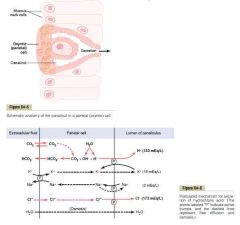
a. 0.8 (155 mM)
(3 million times that of arterial pH) b. 1. Cl is actively transported from the cytoplasm to the canaliculi and Na is actively transported out of the canaliculi to the cytoplasm -together-> up to -70 mV inside canaliculi 2. Negative potential attract mainly K and some Na from the cytoplasm 3. H-K antiporter ATPase (H into canaliculi, K out) (H from H2O dissociation) 4. (The acid is formed at the villus-like projections inside these canaliculi and is then conducted through the canaliculi to the luminal end of the cell) 5. Water diffuse in by osmosis 6. OH from H2O dissociation combine with CO2 to form bicarbonate -> diffuse to ECF |
|
|
Pyloric glands
a. Type of gland b. Location c. Cells (3) d. Secretion (2) |
a. Deep tubular
b. Pyloric antrum (distal 20% of stomach) c. 1. Neck mucus cells 2. Few peptic\chief cells 3. G cells (-> gastrin) (Almost no parietal cells) d. Mucus and gastrin (Guyton) |
|
|
Histamine secretion associated with HCl secretion
a. Name and location of secreting cell b. Association c. Stimulated by |
a. Enterochromaffin-like cells (ECL cells), in oxyntic glands
b. More histamine -> more HCl c. 1. Gastrin (<- G cells of pyloric glands in response to proteins) 2. Acetylcholine 3. Hormonal substances (Guyton) |
|
|
Regulation of pepsinogen secretion
a. Name and location of the secreting cells b. Stimulated by (2) |
a. Peptic\Chief cells, in deep tubular glands of stomach (oxyntic and pyloric), mostly oxyntic.
b. 1. Acetylcholine <- vagus nerve, enteric nervous system 2. Acid in stomach stimulate peptic cell (Probably indirectly via enteric nervous reflexes) |
|
|
Phases of gastric secretion (3)
|
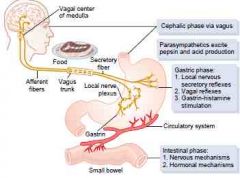
1. Cephalic phase
(Neurogenic signals arise in the cerebral cortex and in appetite centers of amygdala and hypothalamus (sight, touch, thought...) -> dorsal motor nucleus of vagus) (20%) 2. Gastric phase (70%) 3. Intestinal phase (Most in upper duodenum, probably due to small gastrin secretion) |
|
|
Inhibition of gastric secretion by post-stomach intestinal factors (2)
|
1. Inhibitory\Reverse enterogastric reflex
(<- distention, acid, protein breakdown products, irritation -> enteric, parasympathetic, sympathetic -> inhibit stomach secretion & motility 2. Acid, fat, protein breakdown products, non isoosmotic fluid, irritating factor -> release of secretin, GIP, VIP, somatostatin -> inhibit stomach secretion & motility (Guyton) |
|
|
Pancreatic secretions
a. Components - from where b. Stimuli for release |
a.
1. Digestive enzymes <- pancreatic acini (Functions best at pH of 7-8) 2. NaHCO3 and water <- small ductules and larger ducts leading from the acini (Produce pH of around 8) b. 1. Chyme in upper portion of small intestine 2. |
|
|
Pancreatic digestive enzymes
a. For proteins (3) b. For carbohydrates (1) c. For fats (3) |
a.
1. Trypsin (By far most abundant) 2. Chymotrypsin (1 & 2 split whole proteins, but don't release individual amino acids 3. Carboxypeptidase (Split some peptides to individual amino acids) (All are secreted in inactive pro-\-gen form) b. Pancreatic amylase (-> di- and trisaccharides) c. 1. Pancreatic lipase (-> monoglycerides and fatty acids) 2. Cholesterol esterase 3. Phospholipase (split lipids from phospholipids) |
|
|
Activation of pancreatic preoteolytic enzymes
|
1. Released as trypsinogen, chymotrypsinogen and procarboxypeptidase
(Inhibited until intestine by trypsin inhibitor produced by acinar cells) 2. Enterokinase secreted from intestinal mucosa when it comes in contact with chyme activate trypsinogen to trypsin (Trypsinogen can also be autocatalytically activated by trypsin) 3. Trypsin activate chymotrypsinogen -> chymotrypsin and procarboxypeptidase -> carboxypeptidase (Guyton) |
|
|
Bicarbonate secretion in pancreatic juice
a. Highest concentration of bicarbonate in secretion b. Mechanism |
a. 145 mM
b. 1. Cytosolic carbonic anhydrase: CO2 + H2O -> H2CO3 -> H + HCO3 2. HCO3 are actively transported to lumen in association with Na 3. Na-H secondary active antiporter: Na into ICF, H into ECF (Guyton) |
|
|
Regulation of pancreatic secretion
a. Basic stimuli that cause pancreatic secretion (3) - cause what form of pancreatic secretion? b. Phases of pancreatic secretion |
a.
1. Acetylcholine 2. Cholecystokinin (From duodenum and upper jejunum in I cells in presence of chyme) 3. Secretin (From duodenum and upper jejunum in S cells in presence of acidity) 1 & 2 stimulate mostly the acinar cells and digestive enzymes, secretin stimulate ductular cells to secrete large amounts of water and NaHCO3 (The water is needed to "wash out" the digestive enzymes from the acinar ducts) c. As gastric: cephalic, gastric, and intestinal (Intestinal > 70%)(Cephalic & gastric stimulate mostly acinar cells and don't cause enough flow of secretions to enter intestine) (Guyton) |
|
|
Cholecystokinin
a. Produced by which cells b. Stimuli for release c. Effect |
a. I cells of duodenum and upper jejunum
b. 1. Products of partial protein digestion (proteoses, peptones) 2. Long-chain fatty acids c. Stimulate acinar cells to produce digestive enzymes (Account for >70% of total secretion of pancreatic enzymes after a meal) (Guyton) |
|
|
Daily secretion of intestinal juices
a. Saliva b. Gastric secretions c. Pancreatic secretions d. Bile e. Small intestine secretions f. Large intestinal secretion g. Total secretions |
a. 1000 mL (pH 6-7)
b. 1500 mL (pH 1-3.5) c. 1000 mL (pH 8-8.3) d. 1000 mL (pH 7.8) e. 1800 mL (pH 7.5-8) f. 200 mL (pH 7.5-8) g. 6700 mL (Guyton) |
|
|
Physiologic anatomy of biliary secretions - the two stages
|
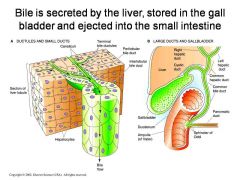
1. Hepatocytes - bile acids, cholesterol, other organic constituents.
(-> Bile canaliculi (between hepatocytes) 2. Canaliculi -> interlobular septa -> terminal bile ducts -> -> hepatic duct -> common bile duct -> duodenum \ cystic duct -> gallbladder During this phase the ductular cells secrete water and NaHCO3 stimulated by secretin. (Concentrated in gall bladder) (Guyton) |
|
|
Gall bladder - function
|
1. Store bile
(30-60 mL, due to its concentrating capacity this can be equal to 450 mL of secreted bile from liver) 2. Concentrate bile (5-20 fold)(Reabsorb Na actively, Cl and H2O follow) (Guyton) |
|
|
Bile salts
a. Intermediates from cholesterol b. Function c. How many % is reabsorbed via the enterohepatic circulation of bile salts? |
a. Cholesterol -> cholic acid or chenodeoxycholic acid -> combine with glycine or taurine: glyco- and tauro- conjugated bile acids -> mainly sodium salts are secreted
(6g are synthesized daily) b. 1. Emulsifying action on fat 2. Help in absorption of fatty acids, monoglycerides, cholesterol adn other lipids by forming micelles (These are semi-soluble in the chyme due to the electrical charges of the bile salts) (Loss of bile -> loss of 40% of fat into feces) c. 94% (50% by diffusion in early small intestine, 50% by active transport in distal ileum) (The quantity of bile secretion is highly dependent on bile salt availability) |
|
|
Liver secretion of cholesterol and gallstone formation
a. How many grams of cholesterol are removed from the blood plasma daily in the formation of bile salts? b. Cholesterol - solubility in water, form in bile c. Causes of gallstones (3) |
a. 1-2 grams
b. Almost completely insoluble, form micelles with bile salts and lechitin (phoshpatidylcholine) c. 1. Too much cholesterol in bile (Partly determined by amount of fat consumed. Cells synthesize cholesterol as one of the products of fat metabolism) 2. Inflammation of cystic epithelium (Ie. from low-grade chronic infection) (Can cause excessive absorption of water and bile, but leaving behind cholesterol) 3. Too much absorption of water or bile salts from bile (Guyton) |
|
|
Brunner glands
a. Type of gland b. Location c. Secretion d. Stimuli for secretion (3) |
a. Compound mucus glands
b. First few centimeters of duodenum (Mainly between pyloric sphincter and papilla of Vater where alkaline secretions enters) c. Large amounts of alkaline mucus (200 mL daily, pH 8-8.9) d. 1. Tactile\irritating stimuli on duodenal mucosa 2. Vagal stimulation 3. Hormonal - especially secretin (Site of 50% of peptic ulcers, maybe because sympathetic stimuli cause inhibition of these glands which leave the mucosa unprotected) (Guyton) |
|
|
Crypts of Lieberkuhn of small intestine\Glands of small intestine
a. Type of gland b. Location c. Cell type (3) d. Stimuli for secretion |
a. Pit type
b. All of small intestine, between villi c. 1. Goblet cells 2. Enterocytes -> watery alkaline secretion (1800 mL\day, pH 7.5-8, active Cl and HCO3 secretion) 3. Paneth cell d. Mainly local enteric reflexes by tactile or irritative stimuli (Guyton) |
|
|
Enterocytes
a. Location b. Secretion c. Enzymes on their brush border (3) d. Life span |
a. Small intestine - in villi and crypts of Lieberkuhn
b. Water alkaline secretion, by active Cl and HCO3 transport c. 1. Several peptidases 2. Disaccharidases: maltase, sucrase, lactase, isomaltase 3. Intestinal lipase (-> glycerol and fatty acids) d. 5 days (Regenerated from base of crypts -> villi) (Guyton) |
|
|
Crypts of Lieberkuhn of large intestine\Glands of large intestine - difference from equivalent in small intestine (2)
|
1. The epithelial cells have almost no enzymes.
2. Consist mainly of mucus cells -> mucous is the main secretory product (Mucus protect against excoriation, adhere fecal matter, and protect the intestinal wall from the great amount of bacterial activity that takes place here.) (Some alkaline-water secreting epithelial cells) (No villi) (Guyton) |
|
|
Diarrhea secondary from infection - mechanism
|
1. Segment of large intestine becomes severely irritated, ie with bacterial infection ->
2. Mucosa secrete large quantities of water and electrolytes (In addition to the viscid alkaline mucus) 3. Cause dilution and faster excretion (Guyton) |
|
|
What is the name of the enzymatic reaction used to digest carbohydrates, fats, and protein?
|
Hydrolysis.
(Guyton) |
|
|
Carbohydrate digestion - steps, responsible enzymes, their action, and their location (3)
|

1. Ptyalin
From parotid gland mainly Split starches to 2-9 glucose polymers (Don't work below pH of 4, probably digest 20-40% of starches. Takes some time before it gets inactivated in the stomach). 2. Pancreatic amylase From pancreas, same function as ptyalin, but more potent (Also alpha-amylase, digest most starches in duodenum after 15-30 minutes, digest 50-80% of starches) 3. Enzymes located on microvilli brush border of enterocytes: lactase, sucrase, maltase, and alhpa-dextrinase (split small glucose polymers) (Guyton) |
|
|
Protein digestions - steps, responsible enzymes, their action, and their location (3)
|
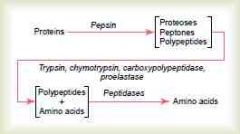
1. Pepsin
Stomach, peptic\chief cells Proteins -> proteoses, peptones, polypeptides (Most important peptic enzyme of stomach, pH optimum of 2-3, one of the few that can digest collagen which is important for meat digestion, 10-20% of protein digestion) 2. Pancreatic secretions Work mainly in duodenum and upper jejunum Trypsin, chymotrypsin (these two split proteins to polypeptides), carboxypolypeptidase (cleave from carboxy site), elastase Proteoses, peptones, polypeptides -> polypeptidases 3. Enzymes on the microvilli brush border of the duodenum and upper jejunum Aminopolypeptidase (split from amino end), Dipeptidases -> di-\tripeptidases, amino acids 4. Intracellular peptidases inside enterocytes (99% of absorbed protein products are single amino acids) (Proteose: nondescriptive term form intermediates of protein metabolism between protein and peptone. Peptone: any of various water-soluble hydrolytic products of partial hydrolysis of proteins) (Guyton) |
|
|
pH of stomach
|
Average around 2.0-3.0
(Guyton |
|
|
Digestion of fats - steps, location, enzymes, action of enzymes
|
1. Stomach by lingual lipase from lingual glands
(Less than 10% of neutral fats) 2. Digestion of fats in intestine a. Emulsification of fat by bile acids and lecithin (Make fat globules readily fragmentable by agitation with the water in the small bowel by decreasing interfacial tension) (Increase surface area of fat up to 1000-fold, the lipase enzymes are water-soluble and can attack the fat globules only on their surface) b. Lipases working in intestine Pancreatic lipase (Most potent, same as with pancreatic amylase) Small amounts of enteric lipase Emulsified fat -> fatty acids and 2-monoglycerides c. Pancreatic cholesterol ester hydrolase and phospholipase A2 d. Bile salts carry away the products and facilitate their absorption (If they would be present they would inhibit fat digestion because the process is to some extent reversible) (Guyton) |
|
|
Stomach
a. Absorptive properties b. What can be absorbed |
a. Poor due to lack of villi structure, viscid mucus, and presence of tight-junctions ("Gastric barrier").
b. Highly lipid-soluble substances like alcohol and some drugs: aspirin. (Guyton) |
|
|
Small intestine - factors facilitating absorption
|
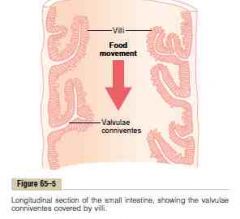
1. Folds of intestinal mucosa called folds of Kercrkring\Circular folds of small intestine
(Increase surface area 3-fold) (Extend circularly, most developed in upper part, extend up to 8 mm) 2. Villi - projections of mucosa (Increase surface area 10-fold) (All of small intestine, but highest density in upper, extend 1 mm) 3. Brush border of microvilli on enterocytes (Increase surface area at least 20-fold) (1000\cell, 1 um long, have contracting actin filaments that cause constant movement to keep them exposed to new materials) (-> > 1000-fold increase. Surface area of 250 m2) (Guyton) |
|
|
Mechanism of absorption of water through the intestinal membrane?
|
Purely passive by diffusion, both through tight junctions and through cells themselves.
(Thus can go both ways depending on osmolarity of the chyme.) (Equilibrate with osmolarity of plasma.) (Guyton) |
|
|
Absorption of sodium
a. Secreted and ingested daily, equal to how much of total sodium in the body b. Mechanism of absorption c. Which hormone increase Na absorption, especially in colon, by increased activation of the transport mechanism |
a. 20-30g secreted, 5-7g ingested. This equals more than 1\7 of the sodium store in the body.
(At least 25g must be reabsorbed) (Extreme diarrhea -> sodium level can be depleted to lethal levels in hours) b. 1. Powered by basolateral Na-K-ATPase 2. Diffuse down electrochemical concentration gradient into the cell. (Sodium concentration in chyme is usually 140 mM) c. Aldosterone (Water and Cl follows) (Guyton) |
|
|
Absorption of chloride ions
a. In the duodenum and jejunum b. In the ileum and large intestine |
a. Mainly by diffusion as a consequence of active Na absorption.
b. Bicarbonate is secreted in exchange for chloride uptake (Provides alkaline bicarbonate to buffer chyme) (Guyton) |
|
|
Absorption of bicarbonate ions
a. In duodenum and jejunum b. In ileum and large intestine |
a. Na-H antiporter -> H combine with HCO3 from chyme to form H2CO3 -> H2O and CO2 -> CO2 is reabsorbed by diffusion
b. Bicarbonate is secreted by an HCO3-Cl exchanger to produce alkaline fluid |
|
|
Cholera toxin - mechanism in producing the severe associated diarrhea
|
Cholera toxin enters epithelial cells of large intestine and terminal ileum -> cause excessive formation of cAMP -> open Cl channels -> Cl diffuse out, though to activate a Na-ATPase to pump Na out to follow Cl -> water follows by osmosis
(Some serious bacterial infections can also cause severe diarrhea by increasing leakage through new epithelial cells in the Crypts of Lieberkuhn) (Can increase secretions up to 10-12L\day, only 6-8L\day can be reabsorbed in the large intestine) (Guyton) |
|
|
Glucose absorption through intestinal membrane - mechanism
|
1. Basolateral Na-K-ATPase
2. Na-Glucose co-transporter 3. Facilitated diffusion of glucose through basolateral membrane (Galactose is transported by a similar mechanism, fructose is transported by facilitated diffusion trough apical membrane and then converted to glucose. Since its not co-transported with Na, its rate of absorption is less than 50% of glucose and galactose) (Guyton) |
|
|
Absorption of proteins through the intestinal membrane - mechanism
|
1. Most by co-transport with Na
(More than 5 different transporters) 2. Some by facilitated diffusion (Guyton) |
|
|
Absorption of fat through the intestinal membrane - mechanism
|
1. Micelle formation with bile secretions -> diffuse to recesses between microvilli of enterocytes
2. Diffuse through micelle and epithelial membrane, micelle remains in chyme (97% of fat is absorbed in presence of bile, 40-50% without bile) 3. Two different paths a. Long-chain fatty acids and monoglycerides: -> smooth endoplasmic reticulum -> form new triglycerides -> chylomicrons -> lacteal lymphatic b. Short- and medium-chain fatty acids: -> diffuse into portal blood (More water-soluble) (Guyton) |
|
|
Absorption in the large intestine - formation of feces
a. How much chyme normally pass through ileocecal valve, how much fluid remains in feces b. Mechanism for absorption |
a. 1500 mL, 100 mL
(Can absorb up to 8L, mostly in the first half - the absorbing colon, the second half is the storage colon) b. 1. Active absorption of sodium (Low permability of tight junctions -> low degree of back flow -> can absorb sodium against a much higher concentration gradient, especially in the presence of aldosterone) 2. HCO3-Cl exchanger (HCO3 help neutralize the acidic end products of bacterial actions in the large intestine) 3. Water follows by osmosis (Guyton) |
|
|
Bacterial action in the colon
a. Which type are most numerous b. Function |
a. Colon bacilli
b. 1. Digestive small amounts of cellulose - provide a few more calories 2. Can help form vitamin K, vitamin B12, thiamine, and riboflavin (The vitamin K is especially important, because this is not ingested sufficiently to maintain adequate blood coagulation) (Guyton) |
|
|
Feces - composition
|
3\4 water
1\4 solid mater: dead bacteria (30%), fat (10-20%), inorganic matter (10-20%), protein (2-3%), and undigested roughage ("grovfor")(food, bile pigments, sloughed cells) ((30%) (Color <- stercobilin, urobilin) (Odor <- bacterial action - caused by type of bacterial flora and food consumed. The odoriferous compounds are indole, skatole, mercaptans, hydrogen sulfide) (Guyton) |
|
|
Achalasia
a. What b. Consequences (2) c. Treatment (2) |
a. Failure of the gastroesophageal sphincter to relax
(Damage in the neural network of the myenteric plexus cause loss of capability of receptive relaxtion) b. 1. Megaesophagus (can hold up to 1L)(Can't empty content for many hours)(infection due to stasis) 2. Ulceration and rupture (Due to infection) c. Antispasmotic drugs (relax smooth muscle), stretching lower esophagus with balloon (Guyton) |
|
|
Gastritis and alchohol and aspirin
a. Mechanism of association |
a. Aspirin and alcohol is damaging to the mucous glands and to the tight epithelial junctions (The gastric barrier) -> H diffuse into mucosa and digestive peptic (gastric) enzymes come in contact with it
(Severe cases can lead to gastric ulcers and gastric atrophy (loss of mucosa and glands: achlorhydria, pernicious anemia) b. Diffusion of peptic digestive enzymes -> peptic ulcer (Guyton) |
|
|
a. Ulcer
b. Peptic ulcer c. Gastric ulcer |
a. A lesion through the skin or a mucous membrane resulting from loss of tissue, usually with inflammation.
(Erosion is a shallow ulcer in the stomach and intestine) b. An excoriated area of stomach or intestinal mucosa caused principally by the digestive actions of gastric juice or upper small intestinal secretions c. Ulcer in stomach (Stedman) |
|
|
Peptic ulcer
a. Usual locations (4) b. Causes (7) |
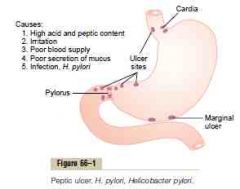
a.
1. Around Pylorus - pre or post 2. Lesser curvature (Less blood flow, ulcerogenic property of refluxed bile) 3. Cardia\Lower end of esophagus (Reflux) 4. Marginal (from gastrojejunustomy) b. 1. High acid and peptic content 2. Irritation 3. Poor blood supply 4. Poor secretion of mucus 5. Infection, H. pylori (Digest mucoid barrier) 6. Alcohol, NSAIDS (aspirin) (Break down gastric barrier) 7. Smoking (increased nervous stimulation of the stomach secretory glands) (Guyton) |
|
|
Peptic ulcer - treatment options (2)
|
1. Antibiotic regimen
2. Histamine blocker - ie ramidine (H2-antagonist) (Reduce gastric acid secretion by up to 80%) |
|
|
Sprue - diseases causing malabsorption by the small intestine
a. Causes (3) b. What substance is hindered from absorption first |
a.
1. Loss\damage of large portions of the small intestine 2. Nontropical\idiopathic sprue\celiac disease (in children)\gluten etneropathy (From toxic effect of gluten on susceptible individuals, damage enterocytes. In mild cases only microvilli, in more severe villi themselves) 3. Tropical sprue (In tropics, inflammation of intestinal mucosa from various infectious agents, can treat with antibiotics) b. Fat - fatty acids in feces (steatorrhea) (Later Protein, carbohydrates -> severe nutritional deficiency Calcium -> osteomalacia Vitamin K -> inadequate blood coagulation Vitamin B12 -> macrocytic anemia)) (Guyton) |
|
|
Disorders of the large intestine - constipation - causes (4)
|
1. Obstruction: tumor, adhesion, ulcer
2. Irregular bowel habits through a lifetime of inhibition of the normal defecation reflexes 3. Hisrchsprung's disease (Loss of ganglion cells in the myenteric plexus in a segment of the sigmoid colon 4. Spastic sigmoid colon (Since there is so low motility in the large intestine, it requires very little spasticity to cause obstruction) (Guyton) |
|
|
Vomiting reflex
a. Stimuli (3) b. Afferent part (2) c. Control center d. Efferent part (3) |
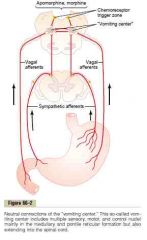
a.
1. Excessive distention, irritation or excitability of pharynx, esophagus, stomach and upper portions of small intestine 2. Stimulation of chemoreceptor trigger zone for vomiting <- apomorphine, morphine, digitalis.. (Small area located bilaterally on the floor of the 4th ventricle) 3. Rapidly changing direction or rhythm of movement (motion sickness) (Motion stimulates receptors in the vestibular labyrinth -> brain stem vestibular nuclei -> cerebellum -> chemoreceptor trigger zone -> vomiting center) b. Vagal and sympathetic afferent nerve fibers c. Vomiting center in medullary and pontile reticular formation (Combination of multiple sensory, motor, and control nuclei) (Also extend to spinal cord) d. CN 5,7,9,10,12 -> upper gastrointestinal tract, vagal and sympathetic nerves -> lower tract, spinal nerves -> diaphragm and abdominal muscles (Guyton) |
|
|
Vomiting act - mechanism
|
Sufficient stimulation of vomiting act -> deep breath, raise hyoid bone and larynx to open upper esophageal sphincter, close glottis, left soft palate -> strong contraction of diaphragm and abdominal muscles simultaneously -> relaxation of gastroesophageal spinhcter -> vomiting
(Antiperistalsis: peristalsis in orad direction preludes vomiting) (Guyton) |
|
|
High-energy phosphate bonds of ATP - energy per mole in the conditions of the body?
|
12 000 calories
(7300 calories under standard conditions) (Guyton) |
|

|
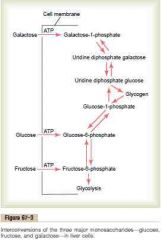
(Guyton)
|
|
|
Which cells have glucose phosphatase in significant amounts - so they can release glucose
|
1. Hepatocytes
2. Renal tubular cells 3. Intestinal epithelial cells (Guyton) |
|
|
How many times more glycogen can hepatocytes store than myocytes?
|
2-3 times
(Hepatocytes: 5-8%, myocytes: 1-3%) (Since myocytes don't have significant glucose-6 phosphatase, they can't release the glucose) (Guyton) |
|
|
Net reaction per molecule of glucose in glycolysis
|
Glucose + 2ADP + 2P -> 2 Pyruvate + 2ATP + 4H
(Guyton) |
|
|
The law of mass action
|
States that as the end products of a chemical reactions builds up in a reacting medium, the rate of the reaction decreases, approaching zero.
(Ie lactate and NADH + H in glycolysis, however, lactate diffuses out of the cell) (Guyton) |
|
|
Which organ is especially capable of converting lactic acid to pyruvic acid and using this for energy?
|
The heart.
(Occurs to a great extent during heavy exercise, when large amounts of lactic acid are released into the blood from the skeletal muscles) (Guyton) |
|
|
Pentose phosphate pathway - resposnible for how many % of glucose breakdown in the liver and in fat cells?
|
> 30%
(Even more in the fat cells) (Guyton) |
|
|
Citric acid cycle - net reaction per molecule of glucose
|
2 Acetyl-CoA + 6 H2O + 2 ADP -> 4CO2 + 16H + 2CoA + 2ATP
(Guyton) |
|
|
Pentose phosphate pathway - net reaction
|
Glucose + 12 NADP+ + 6H2O -> 6CO2 + 12H + 12 NADPH
(Guyton) |
|
|
The 3 most common fatty acids in the body
|
1. Stearic acid (C18:0)
2. Oleic acid (C18:1 cis-9) 3. Palmitic acid (C18:0) (: = number of double bonds, cis-9 double bond at carbon 9 from non carboxy side) (Guyton) |
|
|
Chylomicrons
a. Composition b. Removal |
a.
1. Triglycerides (87%) 2. Phospholipids (9%) 3. Cholesterol (3%) 4. Apoprotein B (1%) (Adsorbed to the outer surface, help to form the structure and prevent its adherence to the lymphatic vessel wall) (0.09-0.6 um) b. Capillary endothelium of the liver and adipose tissue have lipoprotein lipase. This hydrolyze triglycerides and phospholipids. The fatty acids diffuse into hepatocytes and adipocytes (Guyton) |
|
|
Free fatty acids in the blood
a. Mainly from b. Mechanism of release c. Mode of transport |
a. Hydrolysis of fat stored in the adipocytes to be used elsewhere
b. 1. hormone-sensitive cellular lipase <- catecholamines, glucagon 2. Low glucose -> low alpha-glycerophosphate (glucose breakdown product). This is needed to maintain the glycerol portion of triglycerides -> triglycerides are broken down c. Ionize in plasma and bind strongly to albumin (15 mg\dl - low, but it has very high turnover and its level is inducible) (Guyton) |
|
|
After the postabsorptive state, how many % of the lipids in the blood are in the form of lipoproteins (besides chylomicrons)?
|
95%
(700 mg\dl) (Guyton) |
|
|
Lipoproteins - beside chylomicrons
a. VLDL - composition b. IDL - composition c. LDL - composition d. HDL - composition |
a. VLDL:
High triglycerides, moderate cholesterol and phospholipids b. Intermediate-density lipoproteins <- VLDL, some triglycerides is removed c. LDL <- IDL by removal of almost all triglycerides. Have high cholesterol and moderate phospholipids d. HDL High in apolipoprotein (50%), lower concentration of phospholipids and cholesterol (Guyton) |
|
|
Under normal physiologic conditions, the total amounts of triglycerides in the liver is determined to a great extent by?
|
The overall rate at which lipids are being used for energy.
(DM, Early starvation -> massive lipolysis -> transported as FFA -> redeposited as triglycerides in the liver for further use) (Guyton) |
|
|
Reasons why carbohydrates are preferred over fats for energy when excess carbohydrates are available (3)
|
1. Excess glycolysis -> excess alpha-glycerophosphate: substrate for glycerol. -> Bind free fatty acids, thus shifting the equilibrium of free fatty acids and triglycerides towards triglycerides. Consequently, only minute quantities of fatty acids are available to be used for energy.
2. When carbohydrates are available in excess, fatty acids are synthesized more rapidly than they are degraded 3. Intermediates of citric acid cycle stimulate acetyl-CoA carboxylase (the rate-limiting step of fatty acid synthesis) (Guyton) |
|
|
Hormonal regulation of fat utilization
|
1. Insulin lack -> increased fat utilization
2. Catecholamines -> stimulate hormone-sensitive triglyceride lipase (Strong effective during heavy exercise, can rise up to eightfold) 3. ACTH and glucocorticoids also activate hormone-sensitive triglyceride lipase (Ie Cushings can cause ketosis) 4. Growth hormone also stimulate hormone-sensitive triglyceride lipase 5. Thyroid hormones cause rapid mobilization of fats (Indirectly from an increased overall rate of metabolism -> reduction in acetyl-CoA and other intermediates -> increased fat mobilization) (Guyton) |
|
|
Phospholipids - the major types (3)
|
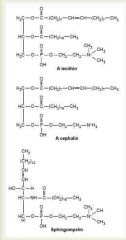
1. Lecithin
2. Cephalin 3. Sphingomyelin (Contain one or more fatty acids, a phosphoric acid radical, and they usually contain a nitrogenous base.) (Guyton) |
|
|
Phospholipids - specific uses (5)
|
1. Constituent of lipoproteins
2. Thromboplastin is composed mainly from phospholipids (Substance from tissues and platelets. Tissue thromboplastin activate extrinsic pathway via VII) 3. Sphingomyelin is an important component of the myelin sheath 4. Can act as donors for phosphate radicals 5. Structural elements - mainly in cell membranes (Guyton) |
|
|
Factors that affect plasma cholesterol concentration (4)
|
1. Amount of ingested cholesterol
(Only deviate 15% from normal, due to feedback mechanism on the rate limiting enzyme HMG-CoA reductase) 2. A highly saturated fat diet (Increase up to 25%. Increased fat deposition in the liver -> increased acetyl-CoA subtstrate for synthesis) 3. Ingestion of highly unsaturated fatty acids lower the cholesterol concentration by an unknown mechanism. 4. Lack of insulin or thyroid hormone increase the cholesterol concentration, increased thyroid hormone decrease it. (Probably by activating metabolic enzymes) (Guyton) |
|
|
a. Atherosclerosis - definition
b. Arteriosclerosis - definition |
a. Disease of the large and intermediate-sized arteries in which fatty lesions called atheromatous
b. General term hat refers to thickened and stiffened blood vessels of all sizes. (Guyton) |
|
|
Atherosclerosis - development after damage to the vascular endothelium
|
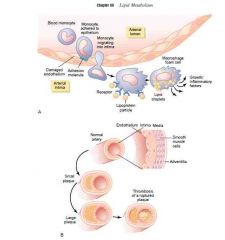
1. Damage to the vascular endothelium ->
2. Decrease their ability to release NO and other substances that help to prevent adhesion of macromolecules, platelets, and monocytes. Increased expression of adhesion molecules on the endothelial cells -> 3. Monocytes and lipids (mainly LDL) accumulate at the site of injury 4. Monocytes cross endothelium and enter the intima -> become macrophage -> ingest and oxidize LDL -> become foam cell 5. Foam cells aggregate in intima and form visible fatty streak. 6. Foam cells secrete growth and inflammatory factors -> hypertrophy and hyperplasia of fibroblasts and smooth muscle cells, and inflammation 7. Fibroblasts deposit excessive dense CT -> sclerosis. Potentiated by deposition of calcium salts on cholesterol and other lipids. (Lose distensibility and are easily ruptured) (Guyton) |
|
|
Risk factors for atherosclerosis
|
1. Increased LDL
(High in cholesterol. <- eating highly saturated fat, obesity, physical inactivity) 2. Familial hypercholesterolemia (Loss of LDL receptor -> loss of feedback inhibition of cholesterol production of liver -> 4-6 levels of LDL -> usually die before 20) 3. HDL - prevent (Might absorb cholesterol crystals that are beginning to be deposited) 4. Physical inactivity 5. Obesity (Increased LDL?) 6. Diabetes mellitus (Increased LDL?)(2x risk) 7. Hypertension (Damage of vascular endothelium) (2x risk) 8. Hyperlipidemia 9. Cigarette smoking (The toxins lower HDL and increase LDL. Nicotine and CO damage endothelium. Can increase the risk of hypertension progressing to malignant hypertension) 10. Being male (Atherogenic androgens? protective female sex hormones?) 11. Excess blood levels of iron (Free radical damage of vascular endothelium?) 12. Lipoprotein (a) (Contain apoprotein(a) which almost double incidence of atherosclerosis) (Hypertension, diabetes mellitus and hyperlidemia synergistically increase the risk of atherosclerosis twentyfold) |
|
|
Proteins
a. Obligatory degradation of proteins - what, amount b. Partial protein c. Complete protein |
a. The loss of proteins per day in a person who ingest no proteins. 20-30 grams\day.
(Gets degraded, deaminated, and oxidized) (-> Minimum 20-30g must be ingested) b. Protein that has a ratio of amino acids different from that of the average body protein c. A protein that has similar ratio of amino acids as the average body protein. (Guyton) |
|
|
Hormonal regulation of protein metabolism
a. Growth hormone b. Insulin c. Glucocorticoids d. Testosterone e. Estrogen f. Thyroxine |
a. Growth hormone
Increase the synthesis of cellular proteins by uncertain mechanism (increased amino acid transport? increased DNA and RNA transcription and translation?) b. Insulin - anabolic. accelerate the rate of amino acid transport (<- stimulus for protein synthesis? increased glucose availability intracellularly reduce the need for using amino acids as an energy source) c. Glucocorticoids - mixed Increase the rate of breakdown of extrahepatic proteins while increasing both liver proteins and plasma proteins d. Testosterone - increased protein deposition, especially the contractile proteins of the muscles (Unlike growth hormone which can cause growth of both muscle and other tissue "indefinitely", testosterone cause the muscles and, to a much lesser extent, some other protein tissues to enlarge for only several months) e. Estrogen - slight increased protein deposition f. Thyroxine - increase rate of both anabolic and catabolic protein reactions (Insufficient substrates and energy -> protein degradation, adequate substrate and energy -> protein synthesis) (Guyton) |
|
|
Liver - its function (5)
|
1. Filtration and storage of blood
2. Metabolism of carbohydrates, proteins, fats, hormones, and foreign chemicals 3. Formation of bile 4. Storage of vitamins and iron 5. Formation of coagulation factors (Guyton) |
|
|
Largest solid\localized organ of the body?
|
The liver.
(1.5kg, 2% of total body weight) (Guyton) |
|
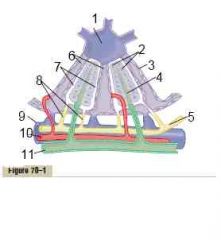
Liver lobule
|

(Guyton)
|
|
|
The liver
a. Basic functional unit b. Number of the basic functional unit c. Cell types (3) d. Space of Disse e. Characteristics of sinusoids (4) |
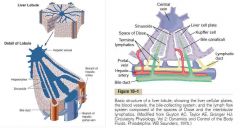
a. Liver lobule
(Hexameric structure around a central vein, composed of many liver cellular plates (of hepatocytes, two cell layers thick, bile canaliculi in between) that radiate from the central vein. Separated by fibrous septa. In the septa are bile ducts which the bile canaliculi empty into, portal venules (<- portal vein), and hepatic arterioles which bring arterialized blood. Portal venules and part of the hepatic arterioles empty into hepatic sinusoids that lie between the cellular plates.) b. 50 000-100 000 individual lobules c. 1. Hepatocytes 2. Endothelial cells 3. Kuppfer cells (part of the reticuloendothelial system) d. Space of Disse\Perisinusoidal space The space beneath the endothelial lining, between the endothelial and hepatic cells. (Connect with lymphatic vessels) e. 1. Large lumen and tortuous (= slow blood flow) 2. Intercellular clefts (Up to 1 um) 3. Fenestrations without diaphragms 4. Fragmented basement membrane (Guyton)(Junqueira) |
|
|
Liver
a. Pressure in portal vein, in hepatic vein b. Mechanism of cirrhosis in causing portal hypertension c. Percent of blood volume normally in the liver |
a. 9 mmHg, 0 mmHg (almost)
(Resistance is very low. 1350 mL of blood flow per minute despite this low pressure gradient) (Pressure in hepatic vein > 3-7 mmHg -> transudation of lymph through capsule into peritoneum) b. Destruction of hepatocytes -> replacement by fibrous tissue -> constrict around blood vessels (<- alcoholism, toxins (carbon tetrachloride), hepatitis, biliary obstruction) c. 10% - 450 mL (Can increase to 1.5L with increased right atrial pressure) (Guyton) |
|
|
Metabolic functions of the liver related to
a. Carbohydrate metabolism (4) b. Fat metabolism (4) c. Protein metabolism (4) d. Other metabolic functions of the liver (4) |
a. Carbohydrate metabolism
1. Storage of large amounts of glycogen 2. Conversion of galactose and fructose to glucose 3. Gluconeogenesis 4. Formation of many chemical compounds from intermediate products of carbohydrate metabolism ( = Glucose buffer function) b. Fat metabolism 1. Beta oxidation is especially rapid in hepatocytes. Excess aectyl-Coa is converted to ketone bodies (Extrahepatic tissues convert ketone bodies back to acetyl-CoA and use it for energy) 2. Synthesis of large amounts of cholesterol, phospholipids, and most lipoproteins 3. Synthesis of fat from proteins and carbohydrates 4. Much of desaturation of fatty acids c. Protein metabolism 1. Deamination of amino acids (-> oxidation, gluconeogenesis) (Small amount in kidneys also) 2. Formation of urea fro removal of ammonia (<- deamination, intestinal bacteria) (Hepatic coma) 3. Formation of plasma proteins (All beside part of gamma globulins) (15-50g\day) 4. Interconversion of the various amino acids (synthesis of all non-essential amino acids) and synthesis of other compounds from amino acids d. 1. Storage site for vitamins (Vitamin A for 10 months, vitamin D for 4 months, vitamin B12 for at least 1 year) 2. Store iron as ferritin 3. Removes hormones and xenobiotics 4. Ca excretion via bile (Guyton) |
|
|
Heme metabolism - steps
|
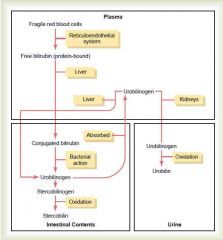
1. Hemolysis (old, damaged) ->
2. Hemoglobin is phagocytosed by the reticuloendothelial system a. Heme -> opened to form four pyrrole chain b. Transformed to biliverdin c. Reduced to free bilirubin 3. Free bilirubin binds to albumin, and gets taken up by hepatocytes a. Conjugate (80% bilirubin glucuronide, 10% bilirubin sulfate) b. Released into bile canaliculi and intestines 4. Intestine a. Half is converted by bacteria to urobilinogen b. Then to stercobilinogen c. Then oxidized to stercobilin 5. Kidneys - some urobilinogen gets reabsorbed in the intestine and some of this (5%) is excreted in the kidneys a. Urobilinogen is oxidized to urobilin in the presence of oxygen (The skin usualyl begins to appear jaundiced when the concentration rises to about 3 times normal - 1.5mg\dl) (Van den Bergh reaction can differentiate between free and conjugated bilirubin. (In total obstructive jaundice there is no urobilinogen in the urine, the stool become clay colored due to a lack of stercobilin, and since only conjugated bilirubin is significantly excreted in the urine, this becomes elevated to. (<- demonstrated by shaking a sample of urine -> foam turns into intense yellow color) (Guyton) |
|
|
Energy available in foods
a. The energy liberated from each gram of carbohydrate as it is oxidized b. The energy liberated from each gram of protein as it is oxidized c. The energy liberated from each gram of fat as it is oxidized |
a. 4 (4.1) Calorie
b. 4 (4.35) Calorie c. 9 (9.3) Calorie (Round to average number due to the fact that these substances vary in the average percentages that are absorbed from the GI tract) (Guyton) |
|
|
Corn is especially low in which amino acid?
|
Tryptophan
(-> protein-deficiency syndrome\Kwashiorkor: failure to grow, lethargy, depressed mentality, edema) (Guyton) |
|
|
Protein metabolism
a. Nitrogen excretion as a method for determining protein metabolism - procedure b. Nitrogen balance |
a. Protein degradation = Nitrogen in urine (as urea, uric acid, and creatinine) \ 0.9 x 6.25
(The average protein contains about 16% of nitrogen (100\16 = 6.25), 90% of the nitrogen is excreted in the urine (mainly as urea, uric acid and creatinine) while 10% is excreted in the feces (\0.9)) b. The ratio between protein degradation and protein ingestion (Negative nitrogen balance means that more is excreted..) (Guyton) |
|
|
The hunger center
a. What is hunger b. Location c. Function |
a. The sensation of hunger is associated with a craving for food and several other physiological effects such as rhythmical contraction of the stomach and restlessness, which cause the person to search for an adequate food supply.
b. The lateral nuclei of the hypothalamus (Stimulation -> hyperphagia, destruction -> inanition (inanis: empty): severe wasting and weakness as result from lack of food, defect in assimilation, or neoplastic disease) c. Excite the motor drives to search for food. (Guyton) |
|
|
The satiety center
a. Location b. Function c. Result of stimulation d. Result of destruction e. Other hypothalamic centers involved in regulation of food intake |
a. Ventromedial nuclei of the hypothalamus
b. Inhibit the feeding center (In the lateral nuclei of the hypothalamus) c. Aphagia d. Hyperphagia e. The paraventricular, dorsomedial, and arcaute nuclei (Guyton) |
|
|
Neurotransmitters and hormones that influence feeding and satiety
a. Anorexigenic (decrease feeding) factors (10) b. Orexigenic (increase feeding) (9) |
a.
1. alpha-MSH 2. Leptin 3. Serotonin 4. Norepinephrine 5. Corticotropin-releasing hormone 6. Insulin 7. Cholecystokinin (CCK) 8. Glucagon-like peptide (GLP) 9. Cocaine- and amphetamine-regulated transcript (CART) 10. Peptide YY (PYY) b. 1. Neuropeptide Y (BPY) 2. Agouti-related protein (AGRP) 3. Melanin-concentrating hormone (MCH) 4. Orexins A and B 5. Endorphins 6. Galanin (GAL) 7. Amino acids (glutamate, GABA) 8. Cortisol 9. Ghrelin (Guyton) |
|
|
Neurons in the arcuate nucleus
a. That stimulate feeding - name, mechanism b. That inhibit feeding - name, mechanism c. Input |
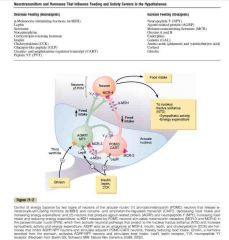
a. Anorexigenic Proopiomelanocortin (POMC)\Cocaine- and amphetamine-related transcript(CART) neurons: produce alpha-MSH and CART
alpha-MSH -> MCR 3,4 (melanocortin receptor) on paraventricular nuclei -> decrease food intake (satiety center and hunger center) and increase energy expenditure (-> nucleus tractus solitarius -> increased sympathetic activity, increased energy expenditure) b. Orexigenic neurons that produce Agouti-related protein (AGRP) and neuropeptide Y (NPY) AGRP is a antagonist of MCR-3 and 4 (Unclear importance), NPY increase hunger (-> hunger center) c. Appear to be the main site of convergence of many of the nervous and chemical signals that regulate the energy stores |
|
|
What is the most common monogenic mutation causing extreme obesity?
|
Mutation of the MCR-4 gene (Melanocortin receptor 4).
(On paraventricular nucleus, mediate satiety and increased energy expenditure by stimulating of POMC\CART neurons of arcuate nucleus) (Anorexia related to severe infections or cancer tumors may be associated by activation of this receptor) (Guyton) |
|
|
Location of neural centers associated with food intake
a. For the mechanics of feeding b. Higher cortical areas related to regulation of food intake |
a. The brain stem
b. 1. Prefrontal cortex 2. Amygdala (Part of olfactory nervous system) (Stimulation can both increase and decrease feeding) (Bilateral total destruction of amygdala cause psychic blindness in choice of food: lose at least partially the appetite control that determines the type and quality of food one eats) (Guyton) |
|
|
Short-term regulation of food intake - for preventing overeating at each meal
a. Inhibitory feedback signals b. Excitatory signals |
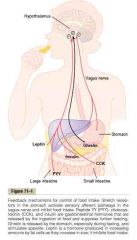
a.
1. Gastrointestinal filling (Especially stomach and duodenum -> vagi 2. Gastrointestinal hormones CCK <- fat mainly (activate POMC\CART neurons) Peptide YY (<- entire GI tract in response to food, especially high fat foods) Glucagon-like peptide (<- food in GI tract -> suppress appetite, stimulate insulin) Insulin 3. Oral factors (Mastication, swallowing, tasting..) (Satiety in patients with complete esophageal fistula after eating) b. Ghrelin (<- oxyntic cells mainly, rise during fasting) (Guyton) |
|
|
Intermediate and long-term regulation of food intake - maintenance of normal quantities of energy stores in the body - factors
|
1. Blood concentrations of glucose, amino acids and lipids
(Ie glucostatic theory of hunger and feeding regulation)(aminostatic, lipostatic) (Rise in glucose -> stimulate glucoreceptor neurons in the satiety center in the ventromedial and paraventricular nuclei of the hypothalamus) (Decrease in glucose -> decrease firing of glucosensitive neurons in the hunger center of the lateral hypothalamus) 2. Cold -> increased feeding, vice versa 3. Feedback signals from adipose tissue Adipocytes -> leptin (proportional to size and number of adipocytes) -> hypothalamus (Guyton) |
|
|
Short-term regulation of food intake - purpose (2)
|
1. Tend to make the person eat smaller quantities at each meal -> food pass through GI tract at steadier pace -> digestive and absorptive functions work at an optimal rate
(Rather than being periodically overburdened) 2. Prevent the person from eating amounts at each meal that would be too much for the metabolic storage systems once all the food has been absorbed. (Guyton) |
|
|
Leptin
a. Produced by b. Work on which receptors where c. Stimulation of these receptors result in (5) |
a. Adipocytes
(Proportional to number and size of adipocytes) b. Leptin receptors at POMC\CART neurons of arcuate nucleus and the paraventricular nucleus (Diffuse through BBB by facilitated diffusion) c. 1. Decreased production of NPY and AGRP (appetite stimulators) by AGRP\NPY neurons of the arcuate nucleus) 2. Activate POMC\CART neurons of arcuate nucleus -> alpha-MSH -> MCR-3,4 -> satiety 3. Increased production in hypothalamus of substances that decrease food intake - ie CRH 4. Increased sympathetic nerve activity -> increase metabolic rate and energy expenditure (via POMC\CART neurons pathway) 5. Decreased insulin secretion -> decrease energy storage (Hyperphagia and morbid obesity results from dysfunction of leptin production or leptin receptors - leptin resistance) (Guyton) |
|
|
Body mass index (BMI)
a. Formula b. Value for overweight c. Value for obesity |
a. BMI = weight in kg\height in meters squared
b. 25-29.9 kg\m2 c. > 30 kg\m2 (Also defined as > 25% body fat in men and > 35% in women) (64% is overweight and 33% obese of adults in US) (Guyton) |
|
|
Relationship of childhood obesity and adult-onset obesity and cell proliferation of adipocytes
|
The rate of formation of new adipocytes is more rapid in the first years of life, and is related to to rate of fat storage.
However, adult-onset obesity is still caused partly by hyperplasia (from fibroblast-like preadipocytes), though the rate of formation is slower. (-> Dismiss the childhood hyperplastic obesity and adulthood hypertrophy obesity idea) (Guyton) |
|
|
Neurogenic abnormalities as a cause of obesity
|
1. Destruction of satiety center (ventromedial nuclei of hypothalamus) <- compressing hypothalamic tumor
2. Neurotransmitter\receptor abnormalities (Higher set-point for satiety in fat individuals. Ie when dieted down to normal weight they experience significantly higher feelings of hunger, have increased formation of orexigenic neurotransmitters such as NPY and decreased formation of anorexic substances such as alpha-MSH) (Guyton) |
|
|
Genetic factors as a cause of obesity
a. How many percent of cases of obesity can be attributed to genetic factors? b. Genes can contribute to obesity by causing abnormalities of (2) c. Three of the most common monogenic causes of obesity are |
a. 20-25%
b. 1. One or more of the pathways that regulate the feeding centers 2. Energy expenditure and fat storage c. 1. Mutation of MCR-4 gene (Most common 2. Congenital leptin deficiency (very rare, mutation of leptin gene) 3. Mutations of the leptin receptor (Very rare as well) (Guyton) |
|
|
Pharmacological treatments of obesity (3)
|
1. Amphetamines or their derivatives
(Activate POMC\CART neurons -> satiety & increased energy expenditure via increased sympathetic activity. This increased sympathetic activity is unwanted because it cause anxiety, and hypertension) 2. Sibutramine (Sympathomimetic, similar side effect as amphetamines) 3. Olristat (Lipase inhibitor - gastrointestinal side effects, loss of fat-soluble vitamins in the feces) (Surgical treatments involve gastric bypass surgery (section of part of small bowel) and gastric banding surgery) (Guyton) |
|
|
Inanition, anorexia, cachexia
a. Inanition b. Anorexia c. Cachexia d. Which factors are believed to cause anorexia-cachexia syndrome |
a. Extreme weight loss, opposite of obesity. <- Lack of food, defect in assimilation (incorporation of digested materials into tissues), neoplastic disease.
(Inanis: empty) b. Reduction of food intake caused primarily by diminished appetite (Psychogenic = anorexia nervosa) c. Metabolic diosrder of increased energy expenditure leading to weight loss greater than that caused by reduced food intake alone. (Kakos: bad, hexis: condition of the body) (Wasting syndrome: anorexia and cachexia, as in patients with AIDS and chronic inflammatory disorders) (50% of cancer patients develop cachexia-anorexia syndrome) c. Inflammatory cytokines (TNF-alpha, IL-6, IL-1beta, proteolysis-inducing factor) (Activate melanocortin system in the hypothalamus) (Guyton) |
|
|
The 3 phases of protein depletion
|
1. Rapid depletion at first
(Use of easily mobilized protein for direct metabolism or conversion to glucose for the brain) 2. Slowed depletion (Preferentially use fat - ketosis, brain principally use beta-hydroxybutyrate)(Gluconeogensis is reduced to 1\3 at least) 3. Rapid depletion shortly before death (Near depletion of fat stores) (Death normally ensues when half the protein is degraded due to its vital functions) (Guyton) |
|
|
Vitamin deficiencies during starvation
a. Which is apparent first b. How fast can it occur |
a. Vitamin B group, Vitamin C
b. In a week (Guyton) |
|
|
Vitamin
a. Definition b. Unit of daily required amount of most vitamins |
a. An organic compound needed in small quantities for normal metabolism that cannot be manufactured in the cells of the body.
b. mg (B1,2,3,6. Vitamin C. ug: Vitamin K, B12) (Guyton) |
|
|
Vitamin A
a. Source b. Necessary for (2) c. Deficiency can cause (5) |
a. Animal tissue, in some vegetables as carotenoid pigments (provitamins)
b. 1. Formation of retinal pigment 2. Normal growth and differentiation of most cells, especially epithelial cells b. 1. Night blindness (Lack of retinal pigment) 2. Scaliness of the skin and sometimes acne (Lack of vitamin A -> stratified and keratinized epithelium) 3. Keratinization of the cornea -> corneal opacity and blindness 4. Failure of reproduction (Atrophy of germinal epithelium) 5. Failure of growth of young animals (The damaged epithelial structures often become infected: conjunctiva, urinary tract, respiratory passages. = anti-infection vitamin) (Guyton) |
|
|
Vitamin B1
a. Synonym b. Function c. Name for deficiency disease d. Mechanism for deficiency e. Consequences of B1 deficiency |
a. Thiamine
b. Thiamine pyrophosphate (TPP) functions as a cocarboxylase with a protein decarboxylase -> decarboxylation of alpha-ketoacids (ie pyruvate) c. Beriberi d. Decreased pyruvate -> acetyl-CoA = decreased carbohydrate and protein oxidation, increased fat utilization e. Beriberi 1. Lesions of CNS and PNS - dry beriberi (Degeneration of myelin sheaths, lesions in PNS -> extremely irritable -> polyneuritis -> pain radiating in the course of peripheral nerves), paralysis) 2. Weakens heart and cause peripheral vasodilation - wet beriberi (Cardiac failure from increased venous return from peripheral vasodilation and directly from primary weakness of the heart muscle) 3. GI tract disturbances (indigestion, severe constipation, anorexia, gastric atony, hypochlorhydria <- inadquate energy of smooth muscle and glands) (Guyton) |
|
|
How are cephalosporins similar/different from penicillin?
|
both have a beta-lactam ring structure but cephalosporins are less susceptible to penicillinases
|
|
|
Vitamin B2
a. Synonym b. Function |
a. Riboflavin
b. Form two coenzymes: flavin mononucleotide (FMN) and flavin adenine dinucleotide (FAD). Operate as hydrogen carrier c. 1. Dermatitis 2. Diarrhea, GI disturbances 3. Mental depression (Similar as niacin deficiency\pellegra) (Guyton) |
|
|
Vitamin B12
a. Function b. Deficiency -> (2) |
(Generic description for compounds exhibiting the biological factor of cyanocobalamin)
a. Prosthetic group containing cobalt for several cobalamin compounds 1. Coenzyme for reducing ribonucleotides to deoxyribonucleotides (-> Promotion of growth and promotion of red blood cell formation and maturation) b. 1. Pernicious anemia 2. Demyelination of the large nerve fibers of the spinal cord, especially the posterior columns -> loss of peripheral sensation, paralysis (Guyton) |
|
|
Folic acid
a. Synonym b. Function (1) c. Deficiency -> (1) |
a. Pteroylglutamic acid
b. Carrier of hydroxymethyl and formyl groups which is involved in synthesis of purines and thymine c. Macrocytic anemia (Guyton) |
|
|
Vitamin B6
a. Synonym b. Function c. Deficiency -> (5) |
a. Pyridoxine
b. Coenzyme for many reactions, especially transaminases -> synthesis & degradation of amino acids (Also believed to be involved in transport of some amino acids across cell membranes) c. 1. Dermatitis 2. Decreased rate of growth 3. Mental deterioration 4. Anemia 5. Fatty liver (Can cause seizures in children) (Guyton) |
|
|
Pantothenic acid
a. Function b. Deficiency -> |
a. Coenzyme A: pyruvate -> acetyl Coa, fatty acyl-CoA
(Both carbohydrate and fat metabolism) b. No definite deficiency syndrome has been proved (Wide occurrence in most foods and small amounts can be synthesized in the body) (Guyton) |
|
|
Vitamin C
a. Fuction b. Deficiency -> name, signs and symptoms |
a.
1. Prolyl hydroxylase: proline -> hydroxyproline. Necessary for cross-bridging of collagen fibers. (Found in subcutaneous tissue, cartilage, bone, teeth..) b. Scurvy 1. Failure of wound-healing 2. Cessation of bone growth (failure to ossify, increased risk of fracture as well) 3. The blood vessels become extremely fragile (failure of the endothelial cells to be cemented together properly, failure to form collagen fibrils normally present in the vessel walls) -> petechiae (Petechiae can be induced by inflating a blood pressure cuff) (Other symptoms: lesions of the gums, loosening of the teeth, stomatitis, cerebral hemorrhage) (Guyton) |
|
|
Magnesium
a. Function b. Toxicity (1) c. Deficiency (3) |
a. Catalyst for many intracellular enzymatic reactions, especially those related to carbohydrate metabolism
b. Depress nervous system neuromuscular system (Blocked by administration of Ca) c. 1. Increased irritability of the nervous system 2. Peripheral vasodilation 3. Cardiac arrhythmias (21g in the body, 1.8-2.5 mM, 0.4g\day) (Guyton) |
|
|
The three most important trace elements
|
1. Iodine
(14 mg in the body, 18 ug\day) 2. Zinc (15mg\day) 3. Fluorine |
|
|
Zinc
a. Function (3) |
a. Integral part of many enzymes
1. Carbonic anhydrase (RBC, renal tubular cells, gastrointestinal mucosa, many glands) 2. Lactate dehydrogenase 3. Some peptidases (Guyton) |
|
|
Fluorine
a. Function b. Fluorosis |
Not necessary for metabolism.
Presence of small amount during the period of live when the teeth are being formed subsequently prevents caries. Suppress the cariogenic process by an unknown mechanism (deposits in the hydroxyapatite crystals of the tooth enamel and combines with and therefore blocks the functions of various trace metals that are necessary for activation of the bacterial enzymes that cause caries) b. Mottled teeth and enlarged bones (Fluorine combines with trace metals in some of the metabolic enzymes, including phosphatases, so that various metabolic systems in the odontoblasts and osteoblasts become partially inactivated) (Guyton) |
|
|
Calories of energy per mole of peptide linkage formation
|
500-5000 calories
(Require four high-energy phosphate bonds to make a peptide linkage in the body -> 4 x 7 000 = 28 000 calories. Far more than 5000 calories) (Guyton) |
|
|
The most abundant store of high-energy phosphate bonds in the cell
|
Phosphocreatine
(3-7 times as abundant, also its high-energy phosphate bond contains 8500 calories per mole under bodily conditions, as opposed to 7200 in ATP. This energy difference cause the reaction to proceed toward formation of new ATP from ADP every time even the slightest amount of ATP expends its energy elsewhere.) (Guyton) |
|
|
Anaerobic sources of energy (3)
|
1. ATP already present (5 mM, 1s)
2. Phosphocreatine (10s) 3. Glycolysis (2 minutes) (From glycogen give 3 ATP, from free glucose from plasma give 2 because it must first use 1 ATP to be phosphorylated). (Guyton) |
|
|
Oxygen debt
a. What b. Duration c. The additional oxygen is used to (5) |
a. The extra consumption of oxygen after completion of strenuous exercise
b. Compensative hyperventilaton can occur to some extent from a few minutes to an hour c. 1. Accumulated lactic acid -> glucose 2. AMP, ADP -> ATP 3. Creatine -> Creatine phosphate 4. Re-establish normal concentrations of oxyhemoglobin and oxymyoglobin 5. Normalize the alveolar PO2 (guyton) |
|
|
Metabolism
a. Metabolism b. Metabolic rate - expressed in terms of c. On average ... % of the energy in foods becomes haert during AT formation |
a. All the chemical reactions in all the cells of the body
b. The rate of heat liberation during chemical reactions (Heat is the end product of almost all the energy released in the body) c. 35% (Another 7% is lost to heat production as the energy of ATP is transferred to the functional systems of the cell. ->-> heat (viscosity of movement, turnover of chemical bonds formed..) (When external expenditure of energy is not taking place, all the energy released by the metabolic processes eventually becomes body heat) (Guyton) |
|
|
The Calorie
a. calorie (small c) b. Calorie (large C) |
a. The quantity of heat required to raise the temperature of 1 gram of water 1 C
b. Kilocalorie - 1000 calories (Guyton) |
|
|
Indirect calorimetry - based on the fact that more than 95% of the energy expended in the body is derived from reactions of oxygen with the different foods
a. How many Calories does 1 L of oxygen metabolized with starch give? b. How many Calories does 1 L of oxygen metabolized with fat? c. How many Calories does 1 L of oxygen metabolized with protein? d. How many Calories does 1 L of oxygen metabolized with the average diet? What is this called? |
a. 5.06 kilocalories
b. 4.70 kilocalories c. 4.60 kilocalories d. 4.825 kilocalories. The energy equivalent of oxygen |
|
|
Energy output can be partitioned into energy used for (4)
|
1. The basal metabolic rate - performing essential metabolic functions of the body
(70kg man, 1650 kilocalories a day) (50-70% in most sedentary individuals) 2. Performing various physical activities (Normally around 25%) 3. Digesting, absorbing, and processing food (70kg man, 200 kilocalories daily) 4. Maintaining body temperature (Guyton) |
|
|
Basal metabolic rate
a. Method for measuring b. Average value for a 70kg male c. Usual unit of BMR d. Factors that regulate metabolic rate (6) |
a. Measure the rate of oxygen utilization over a given period of time under a set of conditions
(Not have eaten food within the last 12 hours, night of restful sleep, no strenuous activity within one hour before the test, eliminate all physical and psychic stress factors, ambient temperature 68-80F, no physical activity) b. 65-70 kilocalories\h (The interindividual differences is due mainly to differences in amount of skeletal muscle. Even under resting conditions, these account for 20-30%) c. Kilocalories \ hour \ m2 d. 1. Thyroid hormone (Levels adapted to climate. 10-20% higher concentration in those of persons living in arctic regions compared to tropic regions) 2. Male sex hormone -> increase (10-15%, slight effect of female sex hormones, much from anabolic effect) 3. Growth hormone -> increase (10-20%, direct stimulation of cellular metabolism) 4. Fever (120%\1C) 5. Sleep -> decrease (Decrease 10-15% during sleep. <- Decreased muscle tone, decreased CNS activity) 6. Malnutrition -> decrease (Prolonged can decrease BMR 20-30%. Sparsity of food substances in the cell. The body temperature may fall several degrees shortly before death) (Guyton) |
|
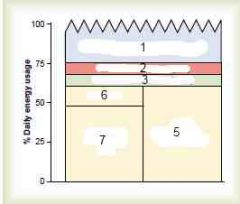
Components of energy expenditure
|

(Thermogenic effect of food: after a meal is ingested, the metabolic rate increases as a result of the different chemical reactions associated with digestion, absorption, and storage of food in the body. Can increase metabolic rate to 4% after a meal exclusive in carbohydrates, and up to 30% in a high-protein meal, part of this effect can last for 3-12 hours. <- Specific dynamic action of protein)
(Guyton) |
|
|
Non-shivering thermogenesis - mechanism
|
Cold (\obesity) -> sympathetic nervous system activation -> norepinephrine and epinephrine increase metabolic activity and heat generation.
(High in brown fat tissue of neonates. Here the oxidative phoshporylation is mainly uncoupled. Sympathetic stimuli can increase the child's metabolic rate 100%. Adults have virtually no brown fat.) (Brown fat has several fat globules and many mitochondria) (Sympathetic nervous system activity is increased in obese persons who have a persistent excess caloric intake. Preventive mechanism?) (Guyton) |
|
|
General gastrointestinal reflexes
a. Gastrocolic reflex b. Ileogastric reflex c. Enteroenteric reflex |
a. The gastrocolic reflex stimulates colonic mass movements in response to food or chyme in the stomach.
b. Ileogastric reflex reduces gastric emptying when there is chyme in the ileum. c. the enteroenteric reflex will relax an area of the intestines when an adjacent area is distended. (Netter) |
|
|
Colipase - what, secreted from, function?
|
Colipase is a protein co-enzyme required for optimal enzyme activity of pancreatic lipase.
It is secreted by the pancreas in an inactive form, procolipase, which is activated in the intestinal lumen by trypsin. The pancreatic lipase cannot access the lipids through the hydrophilic ends of the micelles. The colipase displaces the bile and binds to the lipase, allwoing hydrolysis of the lipids. (Netter) |
|
|
Protein absorption - describe the transport processes used for peptides and amino acids at the luminal and basolateral membrane of the enterocytes and into the capillaries
|
Luminal: amino acids are absorbed using separate Na-dependent cotransporters for basic, acidic, neutral and imino acids (4). Dipeptides and tripeptides enter the cells by H-cotransport
Basolateral membrane: amino acids exit the cell by facilitated transport Capillary: diffusion into capillaries. (Netter) |
|

|
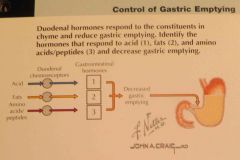
1. Secretin
2. Cholecystokinin, Gastric inhibitory peptide (GIP) 3. Gastrin (Netter) |
|
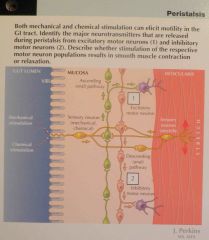
|

(Netter)
|
|
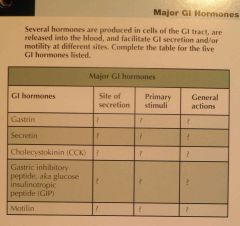
|

(Netter)
|
|
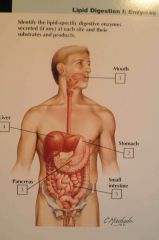
|

(Netter)
|
|
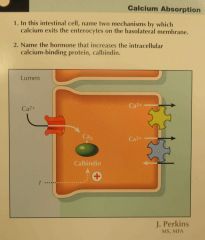
|

(Netter)
|
|
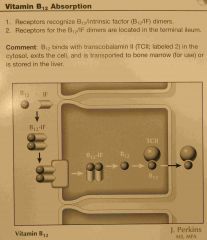
|

(Netter)
|
|
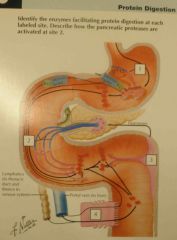
|

(Netter)
|

